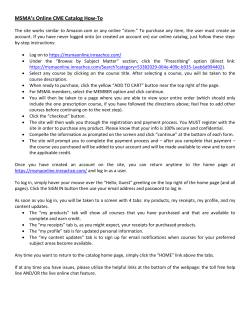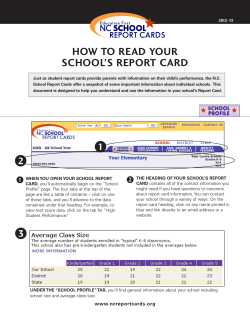
HOW TO ENHANCE SYSTEM MONITORING BASED ON SAP SOLUTION MANAGER ITM262
HOW TO ENHANCE SYSTEM MONITORING BASED ON SAP SOLUTION MANAGER ITM262 Exercises / Solutions Active Global Support / SAP AG TABLE OF CONTENTS Exercise 1 .......................................................................................................................................................................... 4 Exercise 2 ........................................................................................................................................................................ 11 2 BEFORE YOU START Make sure that you strictly follow the instructions as they are given in this document. Exercise Estimated Duration Exercise 1 Technical Monitoring Configuration 25 minutes Exercise 2 Create an Alert and Assign it to 3rd Party Connector (SNMP Trap) 15 minutes 3 EXERCISE 1 TECHNICAL MONITORING CONFIGURATION Estimated time: 25 minutes Objective In the following exercise you will learn how to configure a metric, to monitor the response time of a specific JAVA application method from a 3rd party system, in SAP Solution Manager 7.1. Exercise Description Please configure the provided custom template of a generic product for a 3rd party technical instance so, that the template includes the metric to measure the average response time of method “inboundProcessing” from the native JAVA application “TechEdCustomApp”. EXERCISE 1 – SOLUTION Explanation Connect to Solution Manager and open the work center “SAP Solution Manager: Configuration”. To do so, please open the student share on your desktop and open the folder for session ITM262. Here you can double click the internet shortcut “Connect to SolMan”. A browser window will open with the Log On screen. 4 Screenshot Log on to the Solution Manager system. User: teched<xx> Pass: abc123 Replace <xx> by your group number. Access the work center “SAP Solution Manager: Configuration” and open the “Technical Monitoring” setup from the detail navigation menu. Then go to step 4 “Template Maintenance”. 5 Navigate to: Templates -> Technical Instance -> Generic Product version -> Custom Template for TechEd<your group number> and select it. Your template should be empty (no metric defined). You can check this by selecting the tab “Metrics”. Now, please click the “Edit” button on the upper left side and start the “Expert Mode” by clicking the corresponding button. You are now able to create a new metric. Please lick the “Create” button and select “Metric”. 6 The “Custom Metric Creation Wizard” has been started. The following settings needs to be done in the “Overview” tab of the wizard: Name: Inbound Performance Category: Performance Class: Metric Data type: Integer Unit: Milliseconds You can give your own comment in the “Custom description” section. Now open the “Data Collection” tab. Hint: Do not click on “Next”. The following settings needs to be done in the “Data Collection” tab: Collection Interval: 5 Minutes Data Collector: Introscope EM (push) Data Provider: Z Teched Custom App Perf In the “Collector Input Parameters” section do the following setting: Path_Name: TechEdCustomApp\|WorkerThread\|inb oundProcessing:Average Response Time \(ms\) Hint: You can copy and paste the path name by opening the file “MetricPathName.txt” from your student share (Folder ITM262). Now open the “Threshold” tab. 7 The following settings needs to be done in the “Threshold” tab: Threshold Type: Numeric Threshold (Green/Yellow/Red) Monitored Value: Average Value Trigger if value: Exceeds or equals threshold Green to Yellow: 7000 Yellow to Red: 7500 Now open the “Others” tab. The following settings needs to be done in the “Other” tab: Metric Name: Z_Teched_Exercise_xx Replace xx by your group number. Now click on “Next”. Since we do not have an alert yet, don’t do any assignments here. Now click on “Finish”. Hint: We will come back to this once we have created an alert. Now is your new created metric displayed in the “Metric” tab. In order to persist your modified template, please click on “Save” in the upper left side of the screen. 8 Please confirm the “Select Package” dialog window by clicking on “OK”. Now you have successfully created a custom template. In order to assign the template to a system, please go to the step 5 “Define Scope” in the guided procedure. Please select the system which has been created for your group. To do so, use the filter function in tab “Technical Systems” and filter the “Extended System ID” column for “tec*” entries. Now select the technical system which is named TechEd<xx> (replace xx by your group number). Go to step 6 “Setup Monitoring” of the guided procedure. Switch to the edit mode by clicking the “Edit” button in the upper left corner of the screen. Now select the table row for the technical instance (type icon of your system and click the link in column “Assign Templates”. Open the drop down list and select the template “Custom template for TechEd<your group number>”. Now click the button “Apply and Activate”. From the upcoming options choose “All Managed Objects”. 9 Now you have assigned your template to the technical instance of your system and your metric has been activated. Switch now to the “Technical Monitoring” work center and select “System Monitoring” from the detail navigation menu. Filter the column “Extended ID” in the tab “All Systems” for “tec*” and select the system “TEC<your group number>”. Now click on “System Monitoring” and choose “Start Embedded”. Now is displayed the system list view. Click on your system name in order to open the hierarchy view. In the hierarchy view, open the details for your instance and then the “Instance Performance” section. Now you can see the current measurement of your created metric. Hint: If you can’t see the metric immediately, please wait 1 minute and click then on “Refresh”. You have completed the exercise! You are now able to: 10 Configure a generic custom template and create your own metrics. Assign your template to a monitored object and check the results in system monitoring. EXERCISE 2 CREATE AN ALERT AND ASSIGN IT TO 3RD PARTY CONNECTOR (SNMP TRAP) Estimated time: 15 minutes Objective In the following exercise you will learn how to configure an alert and how to assign it to your own created metric. You will also learn to configure the alert in the way, that in case of an event a SNMP trap will be send. Exercise Description Enter again in the Solution Manager Configuration work center and maintain your monitoring template so, that it includes an alert for your own created metric and make that this alert triggers SNMP trap messages, which can be received and evaluated by a 3rd party product. EXERCISE 2 – SOLUTION Explanation Screenshot Please navigate again to the work center “SAP Solution Manager: Configuration” and open the “Technical Monitoring” setup from the detail navigation menu. Then go to step 4 “Template Maintenance”. 11 Navigate to: Templates -> Technical Instance -> Generic Product version -> Custom Template for TechEd<your group number> and select it. Your template should not have an alert. You can check this by selecting the tab “Alerts”. Now, please click the “Edit” button on the upper left side and start the “Expert Mode” by clicking the corresponding button. You are now able to create a new alert. Please click the “Create” button and select “Alert”. The “Custom Alert Creation Wizard” has been started. The following settings needs to be done in the “Overview” tab of the wizard: Name: Inbound Method Performance Alert Category: Performance Severity: 5 - Medium Active: Yes (checked) You can give your own comment in the “Custom description” section. Now open the “Third-Party Components” tab. Hints: Do not change the settings in the “Incidents” and “Notifications” tab. Do not click on “Next”. 12 Change the default alert settings for third party components to “Active”. Now click the button “Add” in order to assign a third party connector. A Pop Up window displays the available third party connectors. Please select “React to Alerts by sending an SNMP Trap” and then click on “OK”. The third party connector has been assigned and activated. Now open the “Others” tab. Hint: Do not change the settings for “Auto Reactions” and “Rule”. The following settings needs to be done in the “Other” tab: Alert Name: Z_Teched_Alert_xx Replace xx by your group number. Now click on “Next”. 13 The wizard shows you all metrics without alert assignment which are matching with your alert category. In this example just the metric which you have created during the previous exercise is displayed. Click on “Finish”. Now is your new created alert displayed in the “Alert” tab. In order to persist your modified template, please click on “Save” in the upper left side of the screen. Now you have successfully updated your template. In order to assign the modified template to your system, please go to the step 5 “Define Scope” in the guided procedure. Please select the system which has been created for your group. To do so, use the filter function in tab “Technical Systems” and filter the “Extended System ID” column for “tec*” entries. Now select the technical system which is named TechEd<xx> (replace xx by your group number). Go to step 6 “Setup Monitoring” of the guided procedure. Make sure, that you are still in the edit mode. Now check that you still have the custom template assigned to the technical instance. Click the button “Apply and Activate”. From the upcoming options choose “All Managed Objects”. 14 Check that the setup status icon switched to green. You are done with the exercise. As a result of this exercise is your system sending SNMP traps every time the metric is exceeding the threshold. Your trainer will show the console output of the SNMP traps on his laptop. You have completed the exercise! You are now able to: Configure an alert Assign a third party connector to an alert 15 © 2013 by SAP AG or an SAP affiliate company. All rights reserved. No part of this publication may be reproduced or transmitted in any form or for any purpose without the express permission of SAP AG. The information contained herein may be changed without prior notice. Some software products marketed by SAP AG and its distributors contain proprietary software components of other software vendors. National product specifications may vary. These materials are provided by SAP AG and its affiliated companies (“SAP Group”) for informational purposes only, without representation or warranty of any kind, and SAP Group shall not be liable for errors or omissions with respect to the materials. The only warranties for SAP Group products and services are those that are set forth in the express warranty statements accompanying such products and services, if any. Nothing herein should be construed as constituting an additional warranty. SAP and other SAP products and services mentioned herein as well as their respective logos are trademarks or registered trademarks of SAP AG in Germany and other countries. Please see http://www.sap.com/corporate-en/legal/copyright/index.epx#trademark for additional trademark information and notices.
© Copyright 2025











